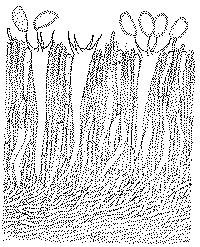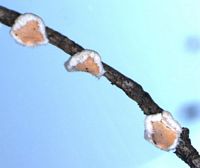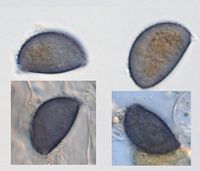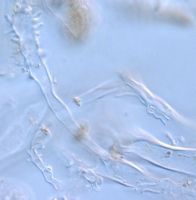|
 Aleurodiscus zealandicus Aleurodiscus zealandicus
SynonymsCyphella zealandica
Chaetocypha zealandica
BiostatusPresent in region - Indigenous. Non endemic
Images (click to enlarge)
Caption: Pl. 24, fig. 5. Aleurodiscus zealandicus, x 1. | 
Caption: FIG. 7. Aleurodiscus zealandicus. Transverse section, showing gloeocystidia and
acanthophyses, x 550. | 
Caption: Fruiting bodies about 4-5 mm across
Owner: Herb PDD | 
Caption: Spores with fine spines, variable in size, the bigger ones about 25 x 15-20 µm.
Owner: Herb PDD | 
Caption: Acanthophyses with spines confined to upper part
Owner: Herb PDD | 
Caption: Acanthophyses with spines confined to upper part
Owner: Herb PDD |
Article: Cunningham, G.H. (1956). Thelephoraceae of New Zealand. Part XI. The genus Aleurodiscus. Transactions of the Royal Society of New Zealand 84(2): 237-268.
Description: Hymenophore annual, ceraceous, pezizoid, attached by a narrow base with margins free,
scattered when 2-7 mm diameter, sometimes confluent into small groups of 2-4; exterior
surface at first white, then tan or isabelline, tomentose, soon smooth, save at margins; margin
raised slightly, upright or inturned, acute, entire; hymenial surface flesh-pink or salmon,
farinose, dimpled or slightly rugulose. Context white, becoming flesh-pink, to 0.5 mm thick,
of radiately arranged densely compacted hyphae, convoluted and partly cemented towards the
base; generative hyphae 4-6 µ diameter, walls 1-2 µ thick, hyaline, branched, septate, with
clamp connexions; tomentum near the hymenial surface composed of cylindrical
acanthophyses covered throughout with blunt spines, remainder of branched hyphae naked or
bearing a few coarse spines. Hymenial layer to 180 µ deep, a close palisade of basidia,
paraphyses, acanthophyses and gloeocystidia. Basidia subclavate, projecting slightly, 60-150
x 20-24 µ, 4-spored; sterigmata arcuate, subulate, to 20 µ long. Paraphyses subclavate, to 70
x 8 µ. Acanthophyses arising in the base of the subhymenium, not projecting, cylindrical, to 6
µ diameter, bearing upon the upper third closely arranged blunt spines, naked below,
occasionally branched near the apices when branches alone bear spines. Gloeocystidia
abundant, arising in the upper layers of the context, penetrating the hymenium to different
levels, flexuous-cylindrical, 60-150 x 10-14 µ, walls 0.5 µ thick. Spores obovate, citriform or
D-shaped, with one or two apiculi, 24-30 x 15-20 µ, walls coarsely aculeate, hyaline, 0.5-1.5
µ thick, amyloid.
Habitat: HABITAT. Scattered on bark of dead branches.
Distribution: TYPE LOCALITY. Winton, Otago, New Zealand.
DISTRIBUTION. New Zealand.
Notes: Fructifications show a close resemblance to those of A. ochraceo-flavus, for in both species
pilei are pezizoid, orbicular and attached by a narrow base. A. zealandicus differs mainly in
the more simple type of tomentum, acanthophyses which are covered with short spines only
upon the upper third, abundant gloeocystidia forming the bulk of the hymenium, larger
differently shaped aculeate spores, and different host range. Collections listed match the type
of Cyphella zealandica in Kew herbarium, ex "Winton, N.Z., No. 230, Dr. S. Berggren".
Article: Cooke, M.C. (1879). New Zealand fungi. Grevillea 8(46): 54-68.
Notes: The dense flexuous hairs are about three to four-tenths of a millemetre long. A most distinct
and notable species. I am indebted to my friend, Mr. W. Phillips, of Shrewsbury, for
assistance in the examination of this and many of the Discomycetes.
|